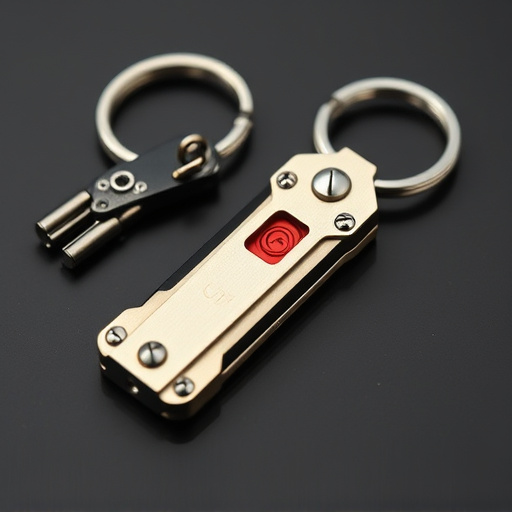Designing "Workplace Approved Self Defense Keychains" requires prioritizing safety, functionality, and compliance with PPE standards. Key features include robust construction using high-quality materials like stainless steel or aluminum alloy, easy accessibility, injury-mitigating design, anti-slip grips, and reliable locking mechanisms. Regular testing and certification by independent labs ensure effectiveness and adherence to evolving industry regulations, shielding organizations from legal liabilities while enhancing user safety and control in diverse workplace environments.
In today’s diverse workplace environment, having a reliable self-defense keychain can be a crucial safety measure. Understanding and adhering to workplace safety standards is essential when designing metal defense keychains. This article provides comprehensive insights into creating effective and ergonomic keychains, focusing on grip design tips, material selection, anti-slip features, and testing for certification. Discover how these considerations ensure your self-defense keychain is not just a tool but a reliable companion, meeting workplace approval.
- Understanding Workplace Safety Standards for Self-Defense Keychains
- Essential Design Considerations for Metal Defense Keychain Grip
- Choosing the Right Metal Alloy for Durability and Ergonomics
- Incorporating Anti-Slip Features for Enhanced Control
- Testing and Certification for Ensuring Effectiveness and Workplace Approval
Understanding Workplace Safety Standards for Self-Defense Keychains
When designing and manufacturing self-defense keychains, understanding workplace safety standards is paramount. These guidelines ensure that the products are not only effective but also safe for everyday use in various environments, including workplaces. Many industries have specific regulations regarding personal protective equipment (PPE), and self-defense keychains fall under this category when used as a last resort for protection against physical harm.
Workplace Approved Self Defense Keychains should meet certain criteria to be considered safe and effective. These include robust construction to withstand impact, easy accessibility for quick deployment, and features that minimize the risk of injury to both the user and potential aggressors. Compliance with relevant safety standards not only protects users but also ensures that organizations remain in adherence to legal requirements, avoiding potential liabilities.
Essential Design Considerations for Metal Defense Keychain Grip
When designing a metal defense keychain grip, safety and functionality should be the top priorities. The key is to create a compact and durable accessory that offers a secure, comfortable grip for easy access during emergency situations. In terms of materials, opt for high-quality metals like stainless steel or aluminum alloy to ensure longevity and resistance against wear and tear. Workplace Approved Self Defense Keychains require a balanced design—not too heavy or bulky—that allows for discreet carrying without causing discomfort or restricting movement.
Additionally, consider incorporating features such as a textured grip surface for enhanced traction during use. The keychain should also include a reliable locking mechanism to prevent accidental opening and ensure the safety of the user. In light of these essential design considerations, the goal is to create a functional self-defense tool that fits seamlessly into daily life without compromising on effectiveness in critical moments.
Choosing the Right Metal Alloy for Durability and Ergonomics
When designing a metal defense keychain, selecting the appropriate alloy is paramount for both durability and ergonomics. Look for alloys known for their strength and resistance to wear, such as stainless steel or high-strength brass. These materials ensure your keychain can withstand regular use while maintaining a secure grip. For instance, 304-grade stainless steel offers excellent corrosion resistance, making it ideal for those who need a reliable self-defense tool in various environments, including the workplace.
Ergonomics play a significant role in user comfort and control. Consider designs that incorporate curved surfaces or ergonomic shapes to fit comfortably in the hand. A balanced weight distribution and an anti-slip finish can further enhance grip and control, making your defense keychain not just sturdy but also user-friendly for quick deployment in stressful situations. Remember, a well-chosen alloy and thoughtful ergonomics transform your keychain from a functional tool into a workplace-approved self-defense solution.
Incorporating Anti-Slip Features for Enhanced Control
Incorporating anti-slip features into your keychain grip design is a crucial step for creating effective self-defense keychains, especially those approved for use in the workplace. These features ensure users have enhanced control over the device during moments of stress or when quick reactions are required. Textured surfaces or specialized rubber grips can significantly reduce the risk of slipping, allowing users to deploy their keychain with precision and confidence.
Workplace-approved self-defense keychains should prioritize user safety and comfort without compromising functionality. Anti-slip technology not only enhances grip but also adds a layer of protection against accidental injuries, which is particularly important in high-pressure work environments where quick access to defense tools can be a matter of safety.
Testing and Certification for Ensuring Effectiveness and Workplace Approval
Testing and Certification are vital steps in ensuring that your metal defense keychain grips are effective and meet workplace safety standards, thus achieving approval from relevant authorities. These processes verify the keychain’s durability, functionality, and safety features. Independent testing labs assess the grip’s ability to provide a secure hold, its resistance to failure under stress, and compliance with industry regulations. Certification ensures that the keychains can withstand rigorous use in various work environments, making them reliable self-defense tools for employees.
Workplace Approved Self-Defense Keychains should adhere to specific criteria, such as grip strength, material safety, and ease of use. Employers often have safety guidelines and requirements, and certified keychains meet these standards, fostering a safer workplace environment. Regular testing and re-certification are necessary to guarantee the keychain’s ongoing effectiveness and to keep up with evolving industry standards.
When designing metal defense keychains, prioritizing both durability and ergonomic comfort is essential to create effective self-defense tools that meet workplace safety standards. Incorporating anti-slip features enhances control, ensuring users can rely on their keychain during critical moments. Choosing the right metal alloy and adhering to rigorous testing and certification processes are vital steps in developing high-quality, workplace-approved self-defense keychains. By following these design tips, manufacturers can produce reliable and safe keychains that empower individuals while meeting industry regulations.
